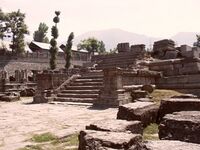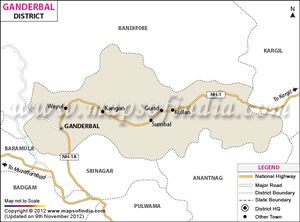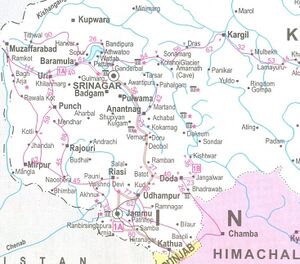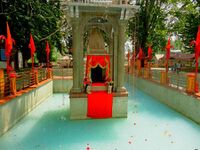Ganderbal
| Author:Laxman Burdak, IFS (Retd.) |
Ganderbal (गांदरबल) is a city and district in Jammu and Kashmir, India. In the olden days the territory of Ganderbal has acted as gate way to the Central Asia by constituting one of the most important station of the erstwhile Silk Route.[1] Rajatarangini mentions this place in 1133 AD as Gandharvana (गंधर्वन).[2]
Location
Ganderbal is located at 34.23°N 74.78°E. It has an average elevation of 1,619 metres above sea level. It is bordered by the Srinagar district in the south, Bandipore to the north, Kargil in the northeast, Anantnag to the southeast and Baramulla in the southwest. Ganderbal district is spread across the Sind River.
The Sindh valley begin from Gandarbal and ends near Baltal at the base of the Zojila Pass.
Variants
- Gandharvana (गंधर्वन) in Rajatarangini[3]
- Gandharvvana (गंधर्व्वन). in Rajatarangini[4]
Origin of name
- The Ganderbal town derives its name from a famous spring Ganderbhavan.[5]
- Legend ascribes origin of Ganderbal to a mythological king named Putraka who created Ganderbal by magic for his queen Patali, which gives its ancient name Pataligrama. It is said that in honour of first son born to queen the city was named Pataliputra.[6]
- Rajatarangini mentions a place - Gandharvana (गंधर्वन).[7]
Jat clans
- Gandhar (गांधर)
- Gandhar Gair (गांधर गैर)
- Gandharva (गंधर्व)
Tahsils
It is divided into seven Tehsils viz, 1. Ganderbal, 2. Kangan, 3. Lar,
Newly created : 4. Tulmulla, 5. Gund, 6. Nagbal and 7. Wakoora.
Villages in Ganderbal Tahsil
Villages: 1 Arch, 2 Baba Dariya Din, 3 Babosi Pora, 4 Badhra Kund, 5 Chandna Deh Now Abad, 6 Chapper Gund, 7 Dev Pora, 8 Gadoora, 9 Gogji Gund, 10 Gotli Bagh, 11 Gund Momin , 12 Gund Rahman, 13 Hakim Gund, 14 Hardo Mardabagh Abad, 15 Harran, 16 Hat Barah, 17 Kastori Pora, 18 Koka Gund, 19 Koreg Domarag, 20 Nuner, 21 Rabitar Gund Roshan Ghat , 22 Rabtar Gundi Roshan, 23 Rakh Harran, 24 Sadra Bagh, 25 Sarich Chodri Bagh, 26 Seh Pora, 27 Shalla Bug, 28 Tulmulla, 29 Urpash,
Source - https://www.census2011.co.in/data/subdistrict/47-ganderbal-ganderbal-jammu-and-kashmir.html
History
No significant ancient building or archaeological site is found in the district today, except for the Naranag temple, as most of the ancient architectural monuments in the area were destroyed during the rule of Sultan Sikander. What must have once been magnificent architectural show pieces are now in grand ruins.
The Ganderbal town is the district headquarter and has derived its name from a famous spring Ganderbhavan. With the passage of time the name got changed into Ganderbal from Gander bhavan, now recognized name and used officially. In the olden days the territory of Ganderbal has acted as gate way to the Central Asia by constituting one of the most important station of the erstwhile Silk Route.[8]
In addition Islamic influence on Kashmir found its way through Sindh valley. Hazrat Shahi Hamdan, Rinchan Shah the first ruler of Kashmir and Mirza Hyder Daughlat have entered Kashmir through Ganderbal popularly known as Sindh valley those days because river Sindh traverses course of about 100 kms through the district with a basin exceeding 1556 kms. The district covers the entire water shed of the river so the Sindh valley and the District has become synonymous.
District Ganderbal holds some of the scared pilgrimage sites like the Holy Amarnath cave, the serene spring of Kheerbhawani. With the presence of tourist resort Sonamarg and Mansbal lake on its fringes, Qamar Sahib and Baba Hyder(RA) Tullamula in its lap and Sindh stream adding its charm and famousness, can contribute to the emergence of this area both as recreational and pilgrim oriented. An easy approach to the Amarnath cave has made the District World renowned.[9]
Jat History
Dama Ram Jakhar - Nayak Dama Ram Jakhar (9.7.1966-5.3.2000) became Martyr of militancy on 5 March 2000 in Gandarbal area of Jammu and Kashmir. He was from Jakharon Ki Dhani, village Chaba village in Shergarh tahsil of Jodhpur district in Rajasthan.
In Rajatarangini
Rajatarangini mentions a place in 1133 AD as Gandharvana (गंधर्वन).[10] Rajatarangini[11] mentions.....And then, Sajjala son of Sujji, Shvetika, son of Sujji's elder brother, and the son of Ulhana were thrown into prison with him. Thus when the king and the minister were under the influence of the wicked, this commotion happened in the year 9 (=1133 AD), on the fifth bright lunar day of summer. Though in some matters the minister Sujji betrayed want of strength, yet the king thinks of him and grieves for him even to this day. It is truly fearful to serve a king, as it is to invoke spirits or to leap over a chasm or to chew poison or to embrace a serpent. If the actions of a man who is faithful to kings are not tested according to their own conscience, he is like one kept before a [ running ] carriage, and
[p.195]: how can he enjoy pleasure ? The king considered Sujji's murder to be wrong, but the people thought it right and as a manifestation of the king's great power.
Rewards to the king's favourites : The king served Sanjapala by making him lord of Kampana, and Kularaja, superintendent of the capital Dhanya and Udaya, favorites of the king, left Mallarjjuna and came to the capital and began to prosper as before. The goddess of prosperity left all others, and changing her fickle character, settled steadfastly on Chitraratha. He had immense wealth, and distressed the country by chastisements, and became uncontrolled ; and even the king was unable to check him.
Kottesha killed Tikka in a village named Gandharvvana and sent his head to the king on the other side [ of the river ].
Tourism
Water rafting tournaments are being organised at the tourist destination of Sonamarg every year, to boost the tourism industry of Kashmir valley. Besides Manasbal lake, Gangabal Lake at the foot of Mount Haramukh is one of the destinations of foreign tourists visiting the valley. Vaishnosar Lake and Gadsar Lake are situated north of Sonamarg.
Manasbal Lake: Manasbal Lake is located in Ganderbal District in the State of Jammu and Kashmir in India. The name Manasbal is said to be a derivative of the Lake Manasarovar. Lake is encircled by three villages viz., Jarokbal, Kondabal (also called Kiln place, is situated on the north-eastern side of the lake) and Ganderbal and is stated to be the deepest lake (at 13 m or 43 ft depth) in India. The large growth of lotus (Nelumbo nucifera) at the periphery of the lake (blooms during July and August) adds to the beauty of the clear waters of the lake. The Mughal garden, called the Jaroka, (meaning bay window) built by Nur Jahan overlooks the lake.
The lake is a good place for bird watching as it is one of the largest natural stamping grounds of Aquatic birds in Kashmir and has the sobriquet of “supreme gem of all Kashmir Lakes”. The rootstocks of lotus plant which grows extensively in the lake are harvested and marketed, and also eaten by the local people.[12]
Gangabal Lake: The Gangabal Lake also called Haramukh Ganga, is a lake situated at the foot of Mount Haramukh[13] in Ganderbal district, north of Srinagar, in Jammu and Kashmir, India. It is an alpine high altitude oligotrophic lake, home to many species of fish, including the brown trout. This lake is considered sacred in Hinduism, and as one of the home of Lord Shiva. The lake has a maximum length of two and a half kilometers and maximum width of one kilometre. It is fed by precipitation, glaciers and springs. The lake water outflows to a nearby Nundkol Lake and then via Wangath Nallah to Sind River.
Naranag Temple

Naranag Temple - The Naranag temple is one of the important archaeological sites of the country. Naranag, a group of temples, is situated in the lap of Harmukh Mountain about 50 kms from Srinagar city. The site consists of a cluster of temples facing each other at a distance of about 100 metres. Historians say that the temple is dedicated to Lord Shiva by the 8th-century ruler Lalithdatiya muktadiya. It is believed that the king Awantivarman paid a visit and donated a pedestal for bathing at Bhutsher. Even today one gets surprised over art and skill of the builders of this temple. Its impressive architecture reveals the glorious past, the magnificent art of the 8th century. The government has only recently constructed walls to protect it from encroachments and nothing else has been done. It is now left in ruins of which only faint traces have survived. This temple has the typical Aryan structure as was present in Aryan Kashmir.
Wicker willow work
Kashmir's traditional wicker craft is dying silent death due to official apathy as the younger generation is not showing interest towards this craft due to less returns. Shallabugh village in central Kashmir’s Ganderbal district is known for its artisans in wicker willow work. However, the artisans here complain that the non serious attitude of successive governments to explore the potential of the local economy has rendered them jobless.
In Shallabugh village over 70 percent of the population including men and women are associated with the work, however the artisans of this heritage craft complained that they have been living in abject poverty.
“We have a huge chunk of our population associated with the willow works , however over the decades due to official apathy many have left this craft to do work in different vocations in order to feed their families,” said Ghulam Nabi, a local artisan who claims to be associated with this work for the last 40 years .
"Now more than 40 years into the profession, he says, the demand for wicker craft has so much dwindled that he is hardly able to make his ends meet.[14]
Shalabugh village in central Kashmir has pioneered the craft of weaving the famous willow baskets. Due to a lack of proper marketing and distribution, the village craftsmen approach intermediaries to sell their products, BILAL HANDOO reports. As even kilometer travel from the main Ganderbal town in central Kashmir takes one to the Shalabugh model village. This village is home to the willow artisans of Kashmir valley. Around 90 percent of the population of Shalabugh has been associated with the willow craft for nearly 50 years now.
Shalabugh village, which earned the status of ‘Model Village’ in 2002, is the largest producer of willow baskets in Kashmir. Nearly 5,000 people belonging to about 600 families of the village depend of willow works for earning a living. The willow products have an attractive face value and intricate designs which make them a hit not only in local markets but they are also exported to India and foreign countries. In Kashmir, the willow crafts are used in weddings and other occasions of festivity.
“It is not only the illiterates who weave willow. There are graduate youth are associated with the trade due to a large demand and supply,” says Bilal Khandey, a Kashmir University research scholar who lives in Shalabugh. He said the educated youth, who constitutes around 30 to 40 percent of village population, were compelled to involve themselves in weaving willow because of unemployment. “In absence of government jobs, the educated youth of the village are turning towards this craft in great numbers,” he added.
Apart from Haren and Shalabugh, villages like Gadora, Kujur, Kahan, Gogjigund, Fakirgund and Sindbal are involved in the manufacture of willow baskets. The raw material for the willow works is obtained after willow trees are cut in mid Oct-Nov. The trees are then put in a boiler and its skin is peeled off. After this, the peeled skin is put under sunlight for three days when it becomes ready for processing and manufacturing.
Once the products are finished, the people of Shalabugh village sell them in the adjoining village called Haren. “The villagers of Haren have well established market links in the Valley as well as in different states of India. We sell our products to the dealers of the village, who later sell them to the dealers in Kashmir, Delhi or in other states,” said Sonauallah Khandey, one of the oldest craftsmen of willow baskets in Shalabugh.
Khandey says the main beneficiaries of willow trade were those who didn’t know the basics of the craft. “The irony of the trade is that the dealers outside Kashmir call themselves chief craftsmen while we are not even appreciated,” he says. Due to a failure of the villagers to market their products, they are forced to sell them to middlemen. “Somehow we have failed to channelize our products by ourselves, which is the reason behind the meager profits we earn at the end,” he says.
There is another undesirable development taking place with willow craft in Shalabugh. In order to meet the growing requirement of raw material, the villagers are cultivating willow on agricultural lands. The people who hold agricultural land claim the practice of cultivating willow has decreased the yield of agricultural land. “Earlier, willow wasn’t grown on the land meant for agriculture. The large participation of unemployed youth and a sudden growth in demand has triggered this crisis,” says Ghulam Hassan, a farmer. He said there was abundant water lodged land in Shalabugh which could have been used for cultivating willow rather than destroying agricultural land. “But that step requires consent of authorities which the villagers have not sought yet,” Hassan says.
It is not clear how Haren pioneered the craft and how it was later learnt by other villages including Shalabugh. “It is not known how these people learnt this craft. In 1955, willow plantation was started in Haren. It reached our village in 1957,” said Sonauallah Khandey, who was a student of class 3 when the trade began in Shalabugh.
A story doing rounds in the village is that a westerner was impressed with his friend who was a resident of Haren village and, as a token of gift; he planted a willow tree in Haren. “I was witness to that development myself. That Englishman wanted to give renewable source of income to the people of Haren which he gave in the form of willow trees,” Sonauallah says.
Interestingly, Haren had made it mandatory for its villagers that this newly acquired craft shouldn’t be passed on to other adjoining villages. They feared that once it was learnt by others, it will impact their trade. But the plan to shield the trade was dealt a blow by craftsman from Chadoora village. ”Two villagers had decided to set up a cottage factory of willow baskets. They had hired employees from Chadoora who leaked the secrets of the trade to others,” says Sonauallah.
Once the art of the craft was passed on to Shalabugh village, Haren village started providing seeds of willow to the people of Shalabugh to obtain raw materials. “They showed this generous gesture only to meet their growing demands,” says Sonauallah.
Ref - https://kashmirlife.net/willow-village-6412/
गान्दरबल
गान्दरबल (Ganderbal) भारत के जम्मू और कश्मीर राज्य का एक ज़िला है। यह पहले श्रीनगर ज़िले का हिस्सा हुआ करता था जिसकी दो तहसीलों (गान्दरबल और कंगन) को लेकर 6 जुलाई 2006 को इस ज़िले का गठन किया गया। गान्दरबल का नामकरण प्रसिद्ध गान्दरभवन झरने के नाम पर पड़ा है। प्राचीन काल में सिल्क रोड का महत्वपूर्ण स्टेशन था और मध्य एशिया का प्रवेशद्वार माना जाता था। कल्हण की राजतरंगिनी[15] में इस स्थान का उल्लेख सन 1133 ई. में गंधर्वन के रूप में किया गया है।
ज़िले के गठन के बाद इसमें छह तहसीलें निर्धारित करी गई: 1. गान्दरबल, 2. तुलमुल, जहाँ खीर भवानी मंदिर स्थित है, 3. वाकूरा, 4. लार, गान्दरबल, 5. कंगन, गान्दरबल, 6. गुंड, गान्दरबल
खीर भवानी मंदिर, तुलमुल, गान्दरबल
खीर भवानी, क्षीर भवानी या राज्ञा देवी मंदिर भवानी देवी का एक प्रसिद्ध मंदिर है। जम्मू और कश्मीर के गान्दरबल ज़िले में तुलमुल गाँव में एक पवित्र पानी के चश्मे के ऊपर स्थित है। यह श्रीनगर से 25 किलोमीटर दूर है। खीर भवानी देवी की पूजा लगभग सभी कश्मीरी हिन्दू करते हैं। महाराग्य देवी, रग्न्या देवी, रजनी देवी, रग्न्या भगवती इस मंदिर के अन्य प्रचलित नाम है। इस मंदिर का निर्माण 1912 में महाराजा प्रताप सिंह द्वारा करवाया गया जिसे बाद में महाराजा हरी सिंह द्वारा पूरा किया गया। पारंपरिक रूप से वसंत ऋतू में मंदिर में खीर चढ़ाया जाता था इसलिए नाम 'खीर भवानी' पड़ा। ऐसी मान्यता है कि किसी प्राकृतिक आपदा की भविष्यवाणी के सदृष, आपदा के आने से पहले ही मंदिर के कुण्ड का पानी काला पड़ जाता है। यह मंदिर कश्मीर के प्रमुख धार्मिक स्थलों में से एक है। मां दुर्गा को समर्पित इस मंदिर का निर्माण एक बहती हुई धारा पर किया गया है। इस मंदिर के चारों ओर चिनार के पेड़ और नदियों की धाराएं हैं, जो इस जगह की सुंदरता पर चार चांद लगाते हुए नज़र आते हैं। ये मंदिर, कश्मीर के हिन्दू समुदाय की आस्था को बखूबी दर्शाता है।
References
- ↑ https://ganderbal.nic.in/history/
- ↑ Kings of Kashmira Vol 2 (Rajatarangini of Kalhana)/Book VIII (i),p.195)
- ↑ Kings of Kashmira Vol 2 (Rajatarangini of Kalhana)/Book VIII (i),p.195)
- ↑ Kings of Kashmira Vol 2 (Rajatarangini of Kalhana)/Book VIII (i),p.195)
- ↑ https://ganderbal.nic.in/history/
- ↑ https://www.brandbharat.com/english/jk/districts/Ganderbal/history.html
- ↑ Kings of Kashmira Vol 2 (Rajatarangini of Kalhana)/Book VIII (i),p.195)
- ↑ https://ganderbal.nic.in/history/
- ↑ https://ganderbal.nic.in/history/
- ↑ Kings of Kashmira Vol 2 (Rajatarangini of Kalhana)/Book VIII (i),p.195)
- ↑ Kings of Kashmira Vol 2 (Rajatarangini of Kalhana)/Book VIII (i),p.194-195)
- ↑ https://ganderbal.nic.in/places-of-interest/
- ↑ "Trekking Kashmir". gaffarakashmir.in.
- ↑ https://www.greaterkashmir.com/business/kashmirs-traditional-wicker-craft-in-last-throes
- ↑ Kings of Kashmira Vol 2 (Rajatarangini of Kalhana)/Book VIII (i),p.195)



